When you want to unlock a new level of confidence and comfort, a portable power station can go a long way. Even a compact Anker 521 Portable Power Station offers peace of mind that you’ll always have some energy at hand. Whether you want to charge your phone while away from the grid or ensure your CPAP always has power, this little workhorse can meet your needs.
But how does the Anker 521 compare to other models? When you dive into the specifications, is it still worth your money?
In this guide for the Anker 521 Portable Power Station, we’ll go into the details so you can see if it’s what you need. Or if you should consider a similar alternative from Anker or another top brand.
We carefully select the products and services we link to. If you buy through our links, we may earn a commission. There’s no extra cost to you and it helps us provide this information.
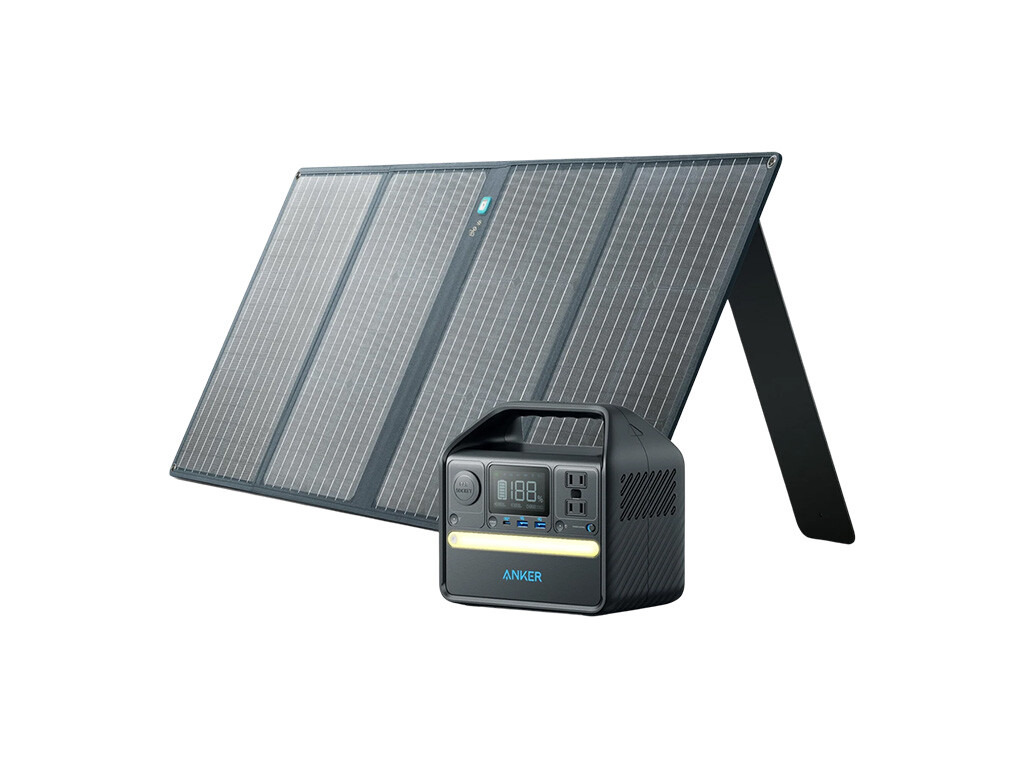
The Quick Rundown: Anker 521
There’s a lot to like about this small power station. No, it won’t power an air conditioner unit or a large fridge. But it will keep your phone charged, many times over again. It can charge laptops, power lights, and handle a lot of small energy needs.
Anker has a long history of creating battery-focused devices with high-quality manufacturing standards. The extensive lineup of Anker Power Stations hold impressive specifications. And the brand is typically very competitive when it comes to price.
The Anker PowerHouse 521 is essentially the brand’s smallest power station, although Anker does make small power banks (including one with an AC outlet). With any power station, solar panel, or electrical gear, it’s important to keep your expectations realistic.
The Anker 521 power station has:
- AC Inverter & Outlets: A basic 200W inverter with 2 AC outlets plus 3 USB ports
- Battery and Charging Rates: 256Wh LiFePO4 battery with 65W charging rates
- Weight: Less than 10lbs (4.5kg) is easy to bring anywhere
These power station specs may not be groundbreaking, but they are solid for this price range. And it’s a well designed power station from a brand you can trust. The inverter size matches the battery capacity quite well. Its charging rates are a little slow, but not tragically so.
This industry is fiercely competitive though. And we’re ready to provide an objective look at how the Anker 521 compares to other power stations. Unfortunately, this is where the 521 portable power station starts to fall short. Here’s a quick look at its rivals:
- Jackery Explorer 300 Plus: Larger 288Wh battery, 300W inverter, faster charging, and 20ms UPS function for nonstop power
- EcoFlow River 2: More powerful 300W inverter, very fast charging rates, and 30ms EPS function
- Bluetti AC2A: Smaller 205Wh battery, larger 300W inverter, very fast charging, and 20ms UPS function
Now don’t go running off too quickly. Even though these other power stations have some superior specs, they also are usually priced higher. This is something that fluctuates as quickly as the wind shifts, so you’ll have to see what today’s prices are. But quite often, the Anker is the best value.
Overall, the Anker 521 Portable Power Station is a high-quality product that holds its own against rivals and will serve lightweight power needs well.

|
Anker 521 PowerHouse |
521 on Anker Buy on Amazon |

|
Anker 521 Solar Generator + 100W Solar Panel |
Buy on Anker Buy on Amazon |
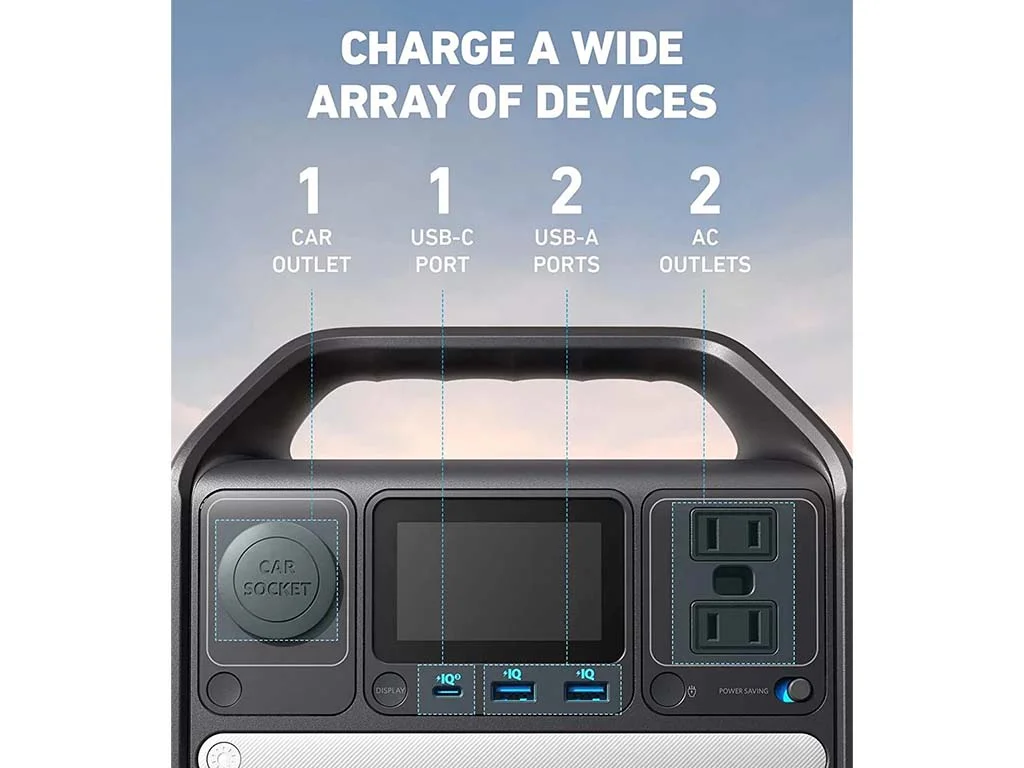
AC Inverter & Outlets
The ways you can plug in your devices are one of the most important things to any power station. This includes the AC inverter, which has a specific rating based on how much power it can provide, as well as a variety of DC outputs, including USB ports.
AC Outlets
The Anker 521 Power Station has a 200W AC inverter. Across its two AC outlets, it can power devices that need up to 200W of power. If you try to use it with a big 500W fridge, it won’t work. And that’s understandable for a small power station. It’s made for small devices. The fact that it has an inverter is a nice touch that you might not even need, considering how many small devices use USB ports or another type of DC connection.
One of the largest missing features from the Anker 521 is the lack of uninterruptable power supply (UPS) function. A UPS can be used to continually power a critical device, like a computer or CPAP machine. You plug the power station into the wall outlet and your critical device. When the outlet doesn’t provide power (outage or blackout), the power station’s battery steps in and your device keeps running
It’s not entirely unusual for small power stations to lack UPS feature. Not too long ago, this was reserved for higher-powered units. But times have changed. By carefully reviewing the best small power stations, we have a list of three others from top brands that have some form of UPS support.
Other Ports and Connections
For the Anker 521 and many small power stations, it’s actually better to use the DC connections when possible. Then you don’t have to turn on the AC inverter, which uses a little power to run and is less efficient overall. It cuts into your battery capacity.
Thankfully, you have 2 x 12W USB-A ports and 1 x 60W USB-C port.
Three USB ports is standard across the spectrum of small 300W power stations. And the 60W from this Type C is enough to run a lot of laptops and other somewhat sizable devices. You also have a 120W car cigarette lighter port, which is useful for things like a small portable fridge or other car-focused electronics.
With 6 total connections including a 60W USB-C port, the Anker PowerHouse 521 has enough connections considering its size. The lack of UPS function is something that could be improved to catch up with other units.
| Product | Anker Powerhouse 521 |
|---|---|
| AC Output | 200W |
| 120V Outlets | 2×1.82A |
| UPS / EPS | – |
| USB-A Ports | 2x12W |
| USB-C Ports | 1x60W |
| Cigarette Lighter | 1x 120W |
| Buy Now | Buy 521 |
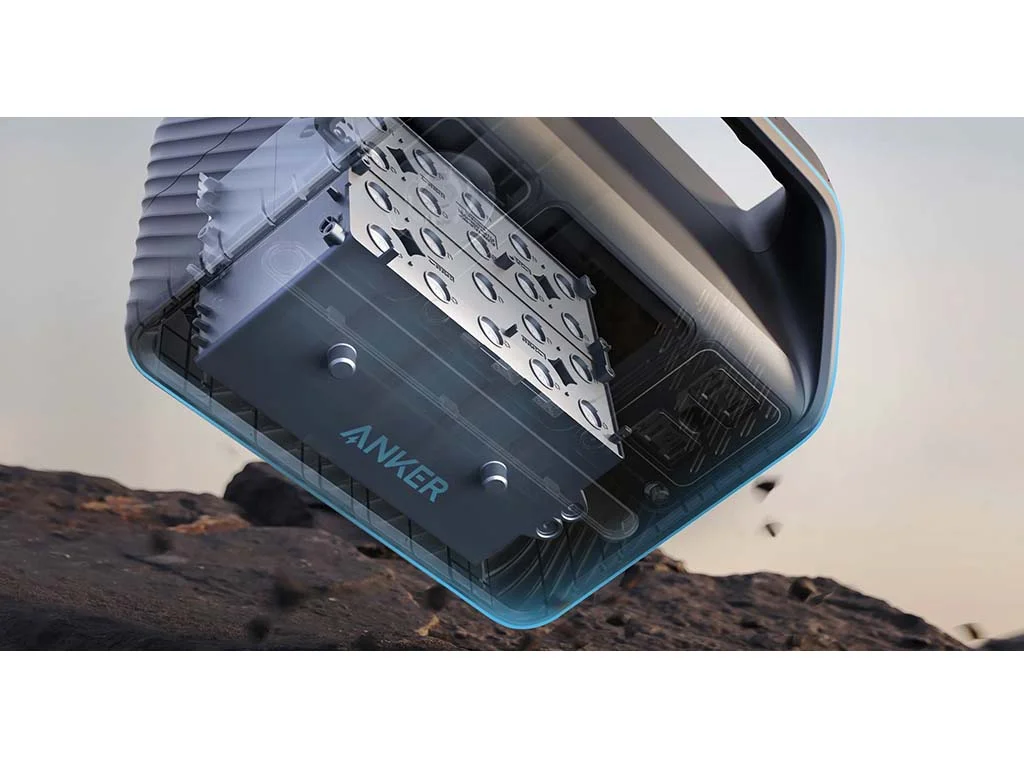
Battery and Charging Rates
The inverter and the connections determine how much power can rush out at one time. But the battery determines how long the power station can run your devices for. The type of battery also has a large impact on how long you can expect the power station to last.
Battery Capacity
What you get from a power station in this category is somewhere between 200Wh to 300Wh. The Anker 521 splits that range with a 256Wh battery capacity. It’s not the biggest in the class, and not the smallest either.
How long does a 256Wh battery last? Here’s a quick calculation you can use to figure this out for any device or group of devices:
- Find the power consumption of the device(s) in watts
- Take your 256Wh battery and divided by the watts of the device(s)
- Multiply by 80% to account for system inefficiencies and unusable battery space (Removing 20%)
- You’re left with an estimate of the hours the battery will last
- Watt-hours / Watts x 80% = Hours of runtime
You can also use a different approach, if you know the battery size of your devices. Then you can take the Wh of the power station and divide by the Wh of your device. Then take off about 20%. For example, a typical phone has about 10Wh to 15Wh battery. 256Wh divided by 12Wh is about 21. Take off about 20% and you’re left with about 17 phone charges within the Anker 521 power station.
As you can see, this is a great solution for charging phones and keeping small devices powered on. But when you move to a big 200W device, then you only get about one hour. There are limits and this applies to any power station in this same segment.
Battery Type
The battery chemistry determines how many times you can charge and discharge the power station. Most power stations use some form of lithium ion battery. But it can be NMC or LiFePO4 (LFP), which have dramatically different lifespans. NMC is much shorter with about 500 cycles.
This Anker 521 features a LiFePO4 battery type and it is expected to keep at least 80% of its capacity even after being charged and discharged over 3,000 times. That’s about 8 years of daily use. It’s impeccable and you can’t find a better option. Anker provides a 5 year warranty to showcase its expectations that this will be a long lasting power station, which matches most premium power station brands.
Charging Rates
Finally, let’s talk charging rates.
You might think that if you want to charge a power station, they would all charge at the same rate when connected to the same source. But that’s not the case.
Power stations have internal charge controllers to feed the power into the battery. These controllers determine how many solar panels you can connect and how fast it will charge from any source. And the Anker 521 has one 65W charging input, which means it will take about 4.7 hours to charge at that rate.
This is another area that Anker falls behind other power stations you compare it to. Similar models from EcoFlow, Bluetti, and Jackery all have faster charging, with EcoFlow taking the top spot with a rapid 360W charging speed from AC outlets (less than 1 hour). Bluetti has the fastest solar input at 200W (~1.2 hours). Many power stations have separate inputs for AC and solar (DC).
While Anker’s battery capacity and chemistry are excellent, the slow charging is a bit of a sore spot. Less than 5 hours isn’t the end of the world and it’s faster than other models, but our alternative three choices all have faster charging rates for both solar and regular AC outlets.
| Product | Anker Powerhouse 521 |
|---|---|
| Battery | 256Wh |
| AC Input | 65W |
| AC Recharge Hours (Est.) | 4.7h |
| Solar Input | 65W |
| Solar Recharge Hours (Est.) | 4.7h |
| Warranty | 5 years |
| Solar Input 1 Volts Min | 11V |
| Solar Input 1 Volts Max | 28V |
| Solar Input 1 Amps | 5.5A |
| Battery Type | LiFePO4 / LFP |
| Battery Cycles | >3,000 |

Weight and Dimensions
The Anker 521 Portable Power Station is perfectly portable, easy to bring anywhere, and doesn’t take up much storage space at all. You don’t really have much to worry about in this class of power stations as they’re all very similar, but if you like to count the ounces or grams, then Anker is slightly over others by a pound or so.
At less than 10lbs (4.5kg), this likely isn’t something to stop you from buying this. It’s a great camping solar generator or small emergency backup power station.
The one thing that does have some room for improvement is the handle design. It sticks out from the top of the power station, making it so stacking items on top of it is more challenging. This is another improvement other brands have made by hiding the handle on the back or going without it altogether.
| Product | Anker Powerhouse 521 |
|---|---|
| Weight (lbs) | 9.6lbs |
| Weight (kg) | 4.3kg |
| Dimensions (in) | 8.5×8.3×5.7in |
| Dimensions (mm) | 216x211x144mm |
| Buy Now | Buy Now |
| Buy on Amazon | Buy on Amazon |

|
Anker 521 PowerHouse |
Buy on Anker Buy on Amazon |

|
Anker 521 Solar Generator + 100W Solar Panel |
Buy on Anker Buy on Amazon |

Anker 521 Power Station Comparisons
It’s time to take a good look into the comparisons between the Anker PowerHouse 521 and other power stations.
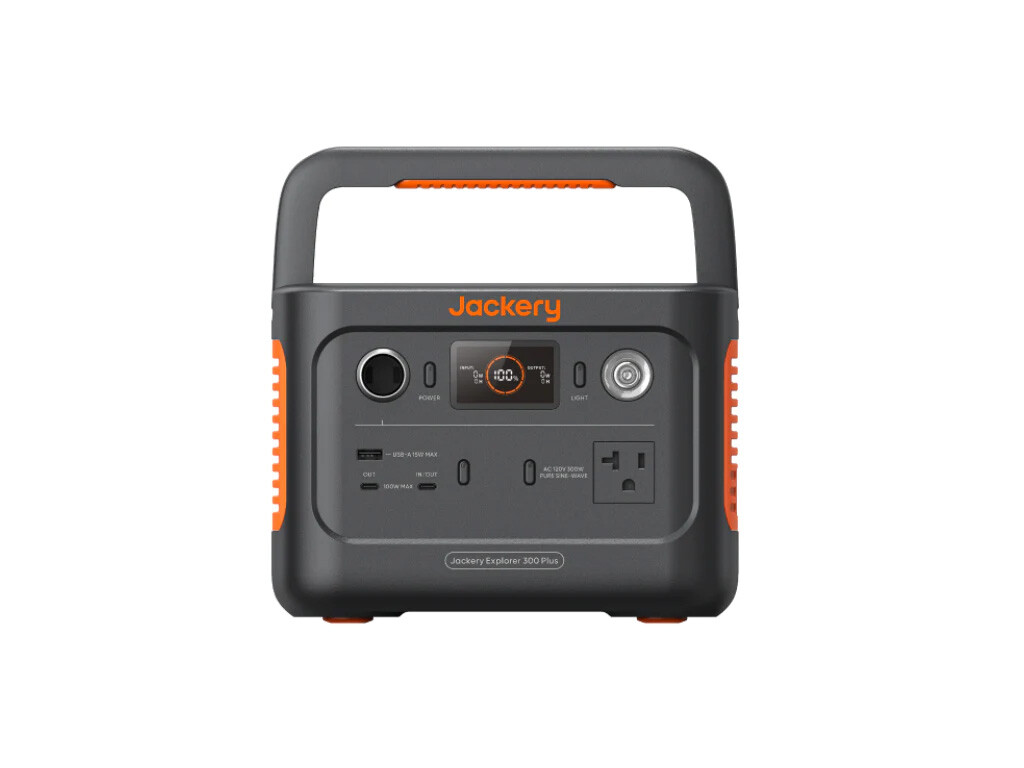
Anker 521 vs. Jackery Explorer 300 Plus
Like we’ve said from the start, the competition within the small power station segment is very tough. The Jackery Explorer 300 Plus is one of the most impressive contenders, hitting the top of the market in nearly every major spec and feature.
Jackery is one of the oldest brands in the power station game. And for a short moment, newer brands like EcoFlow and Bluetti were able to push against this champion with some ease. But as its released updated models, the comparison of Jackery specifications and designs have caught back up.
Not only does the Jackery 300 Plus have a the largest in-class 288Wh battery and a 300W inverter that matches the other rivals, but it also has a 20ms UPS function.
The UPS function can be critical for those that need it. If you want to use this power station to provide constant power to any device while usually plugged into a wall outlet, then the Anker doesn’t cut it. But Jackery and Bluetti both have this 20ms UPS.
Jackery pairs that 20ms with the largest battery. This is a reason to go for it.
One other big upside to the Jackery is that it has the ability to connect to the Jackery app through WiFi and Bluetooth. While other brands have an app for their larger power stations, Bluetti AC2A is the only one that can connect and it only uses Bluetooth. So if a remote monitoring and control of your power station is a priority, the Jackery Explorer 300 Plus is a great choice.
The charging speeds for this Jackery are about double the Anker. It can charge in about 3 hours from a wall outlet or about 3.5 hours from 100W of solar power (which will usually require a panel that’s about 120W or bigger to achieve).
When it comes to the Anker 521 vs. Jackery 300 Plus, there’s just no doubting the Jackery’s superiority.
However, there are two things to keep in mind:
- Material difference? For the most part, these difference in specs is very narrow. The UPS and app features are two that might be big enough to worry about.
- Money talks: The Jackery unit is often much more expensive than the Anker 521.
So which one is right for your needs? First, I suggest checking the current price of both. Then you can make an informed decision based on how much value you put into the slightly better specs and features of the Jackery Explorer 300 Plus compared to the Anker 521 Portable Power Station.
| Product | Jackery Explorer 300 Plus | Anker Powerhouse 521 |
|---|---|---|
| Battery | 288Wh | 256Wh |
| AC Output | 300W | 200W |
| AC Input | 120W | 65W |
| AC Recharge Hours (Est.) | 2.9h | 4.7h |
| Solar Input | 100W | 65W |
| Solar Recharge Hours (Est.) | 3.5h | 4.7h |
| Warranty | 3-5 years | 5 years |
| Weight (lbs) | 8.27lbs | 9.6lbs |
| Weight (kg) | 3.75kg | 4.3kg |
| Battery Type | LiFePO4 / LFP | LiFePO4 / LFP |
| 120V Outlets | 1×2.5A | 2×1.82A |
| UPS / EPS | 20ms | – |
| USB-A Ports | 1x15W | 2x12W |
| USB-C Ports | 1x100W; 1x15W | 1x60W |
| DC 5521 (Barrel Plug) | – | – |
| Cigarette Lighter | 1x120W | 1x 120W |
| Connectivity | WiFi / Bluetooth | – |
| User Manual | User Manual | User Manual |
| Buy Now | Buy 300 Plus | Buy Now |
| Buy on Amazon | 300 Plus on Amazon | Buy on Amazon |

|
Jackery Explorer 300 Plus |
300 Plus on Jackery 300 Plus on Amazon |

|
Anker 521 PowerHouse |
Buy on Anker Buy on Amazon |
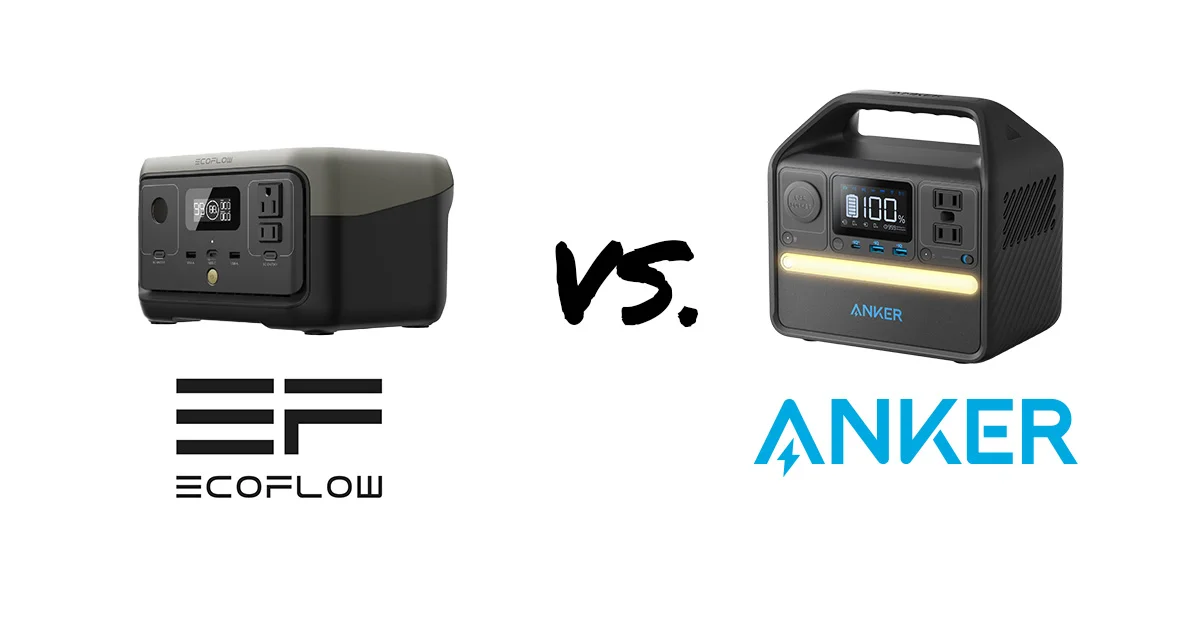
Anker 521 vs. EcoFlow River 2
EcoFlow power stations are some of the most impressive. And the brand’s fanatic customer base can testify to that. But a lot of that momentum comes from EcoFlow’s largest power stations, like the Delta Pro Ultra and Delta Pro 3.
The rest of the EcoFlow specs and products are still worth checking out. In fact, the River 2 is a downright impressive power station. Compared to the Anker 521, the EcoFlow River 2 has:
- Same 256Wh LiFePO4 battery, same 5 year warranty, and identical outlets/ports
- More powerful 300W inverter with 30ms EPS function
- The fastest charging rates around (less than 1 hour from an outlet)
It’s another very close matchup where both are so close that we’re really splitting hairs. But when you bring out the microscope, the inverter difference and the charging rates lean the scale toward the EcoFlow River 2.
The River 2’s 30ms EPS is longer than the 20ms UPS for the Jackery and Bluetti on this list. This 10ms might be the difference between your computer or router staying powered up vs. it rebooting due to rapid power loss. It really depends on your device. But for those that need UPS function as a priority, the Jackery or Bluetti will do better than this EcoFlow. The Anker 521 does not have this feature at all.
We have a full in-depth comparison of the Anker 521 vs. EcoFlow River 2 if you want to take a closer look into this power station matchup.
| Product | EcoFlow RIVER 2 | Anker Powerhouse 521 |
|---|---|---|
| Battery | 256Wh | 256Wh |
| AC Output | 300W | 200W |
| AC Input | 360W | 65W |
| AC Recharge Hours (Est.) | 0.9h | 4.7h |
| Solar Input | 110W | 65W |
| Solar Recharge Hours (Est.) | 2.8h | 4.7h |
| Warranty | 5 years | 5 years |
| Weight (lbs) | 7.7lbs | 9.6lbs |
| Weight (kg) | 3.5kg | 4.3kg |
| Battery Type | LiFePO4 / LFP | LiFePO4 / LFP |
| 120V Outlets | 2 | 2×1.82A |
| UPS / EPS | 30ms (EPS) | – |
| USB-A Ports | 2x12W | 2x12W |
| USB-C Ports | 1x60W | 1x60W |
| DC 5521 (Barrel Plug) | – | – |
| Cigarette Lighter | 1x100W | 1x 120W |
| Connectivity | – | – |
| User Manual | User Manual | User Manual |
| Buy Now | Buy R2 | Buy Now |
| Buy on Amazon | Buy on Amazon | Buy on Amazon |
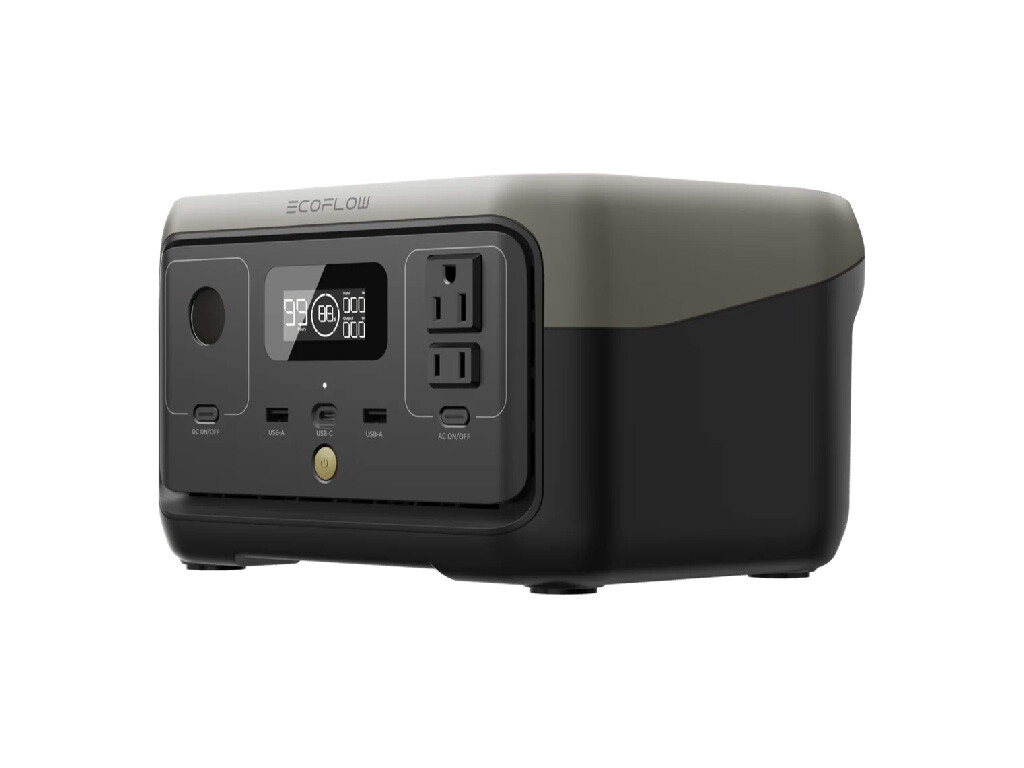
|
EcoFlow RIVER 2 |
R2 on EcoFlow R2 on Amazon |

|
Anker 521 PowerHouse |
Buy on Anker Buy on Amazon |
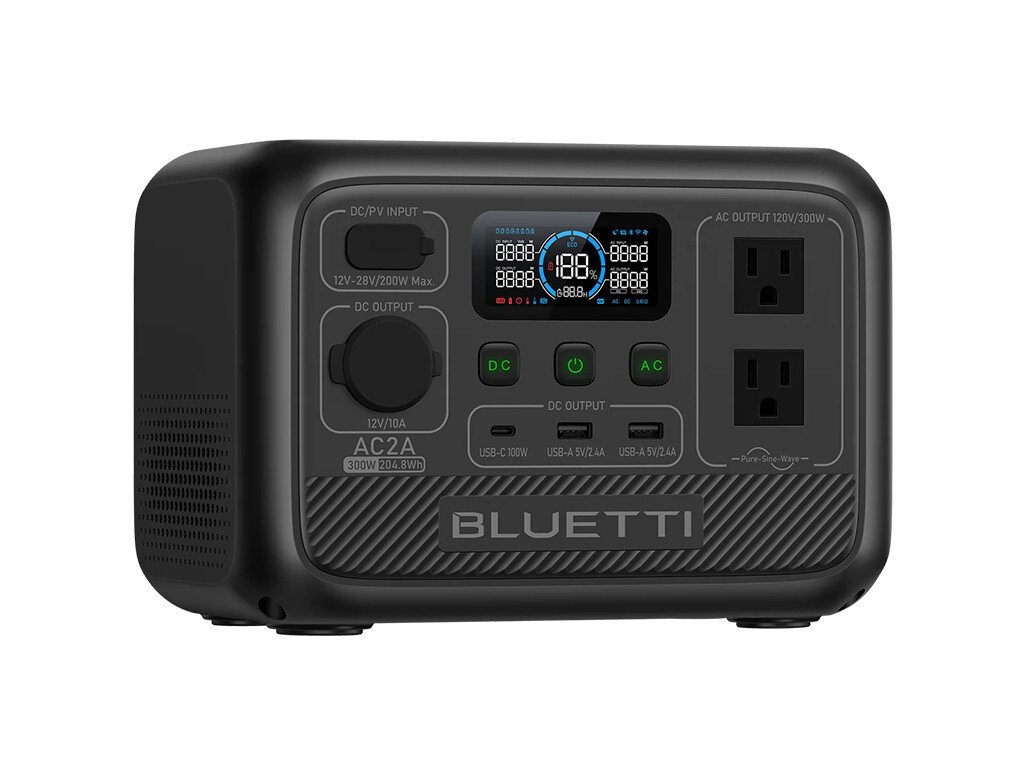
Anker 521 vs. Bluetti AC2A
After reviewing many power stations, one other that is worth comparing to the Anker 521 is the Bluetti AC2A. It’s another tight battle.
The truth is that Bluetti has so many power stations, you can almost always find one that has what you need. If you want to go slightly up from the Anker 521 and Bluetti AC2A, then the Bluetti EB3A is there to meet you (with a higher price, of course).
But sticking to the AC2A and you’ll find yet another very similar choice to the rest on this list, and yet another option from the Bluetti brand that comes with an incredible reputation backed by a 5 year warranty.
Compared to the Anker 521, the AC2A has:
- Larger 300W inverter with 20ms UPS, plus the fastest solar charging rate (200W) and Bluetooth app connection
- Identical battery type, warranty, and outlets/connections
- The smallest battery in the bunch at 205Wh
Again, we’re looking at two power stations that are so similar most people would have trouble spotting a difference. But the 20ms UPS and fast solar charging can be a big deal for some people.
Overall, we like the Bluetti AC2A over the Anker 521, but not quite as much as the Jackery Explorer 300 Plus due to its 20ms UPS match and larger battery that’s nearly 300Wh (about 50% larger than this Bluetti). Price is going to matter a lot though.
| Product | BLUETTI AC2A | Anker Powerhouse 521 |
|---|---|---|
| Battery | 205Wh | 256Wh |
| AC Output | 300W | 200W |
| AC Input | 270W | 65W |
| AC Recharge Hours (Est.) | 0.9h | 4.7h |
| Solar Input | 200W | 65W |
| Solar Recharge Hours (Est.) | 1.2h | 4.7h |
| Warranty | 5 years | 5 years |
| Weight (lbs) | 7.9lbs | 9.6lbs |
| Weight (kg) | 3.6kg | 4.3kg |
| Battery Type | LiFePO4 / LFP | LiFePO4 / LFP |
| 120V Outlets | 2×4.8A | 2×1.82A |
| UPS / EPS | 20ms | – |
| USB-A Ports | 2x12W | 2x12W |
| USB-C Ports | 1x100W | 1x60W |
| DC 5521 (Barrel Plug) | – | – |
| Cigarette Lighter | 1x120W | 1x 120W |
| Connectivity | Bluetooth | – |
| User Manual | User Manual | User Manual |
| Buy Now | Buy AC2A | Buy Now |
| Buy on Amazon | AC2A on Amazon | Buy on Amazon |

|
BLUETTI AC2A Portable Power Station |
AC2A on Bluetti AC2A on Amazon |

|
Anker 521 PowerHouse |
Buy on Anker Buy on Amazon |

Anker 521 Full Specs and User Manual
Here is a chart of the specs for the Anker 521 power station, including a link the Anker User Manual with a few more details.
| Product | Anker Powerhouse 521 |
|---|---|
| Battery | 256Wh |
| AC Output | 200W |
| AC Input | 65W |
| AC Recharge Hours (Est.) | 4.7h |
| Solar Input | 65W |
| Solar Recharge Hours (Est.) | 4.7h |
| Warranty | 5 years |
| Weight (lbs) | 9.6lbs |
| Weight (kg) | 4.3kg |
| Dimensions (in) | 8.5×8.3×5.7in |
| Dimensions (mm) | 216x211x144mm |
| Solar Input 1 Watts | 65W |
| Solar Input 1 Volts Min | 11V |
| Solar Input 1 Volts Max | 28V |
| Solar Input 1 Amps | 5.5A |
| Battery Type | LiFePO4 / LFP |
| Battery Cycles | >3,000 |
| 120V Outlets | 2×1.82A |
| UPS / EPS | – |
| USB-A Ports | 2x12W |
| USB-C Ports | 1x60W |
| Cigarette Lighter | 1x 120W |
| User Manual | User Manual |
| Buy Now | Buy Now |
| Buy on Amazon | Buy on Amazon |

|
Anker 521 PowerHouse |
Buy on Anker Buy on Amazon |

|
Anker 521 Solar Generator + 100W Solar Panel |
Buy on Anker Buy on Amazon |
Wrap Up
Coming from an excellent power station brand with a long history of battery production expertise, the Anker 521 Portable Power Station is reliable and efficient. It has enough battery to charge a phone nearly 20 times, a small inverter to use for devices that need it, and is built to last. The comparison to other power stations is very close, but the Anker 521 is missing a UPS function and has slightly slower charging rates.
Did these not quite hit what you’re looking for? You might be better off jumping up to the next level and can see them on our list of 500W Power Stations. Or maybe you’re ready to calculate how many solar panels you need.







